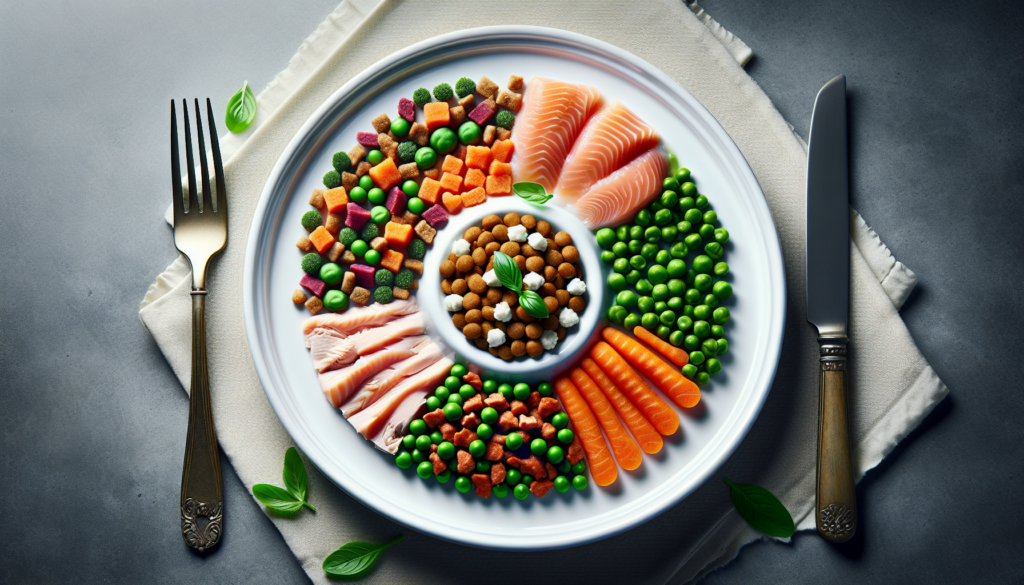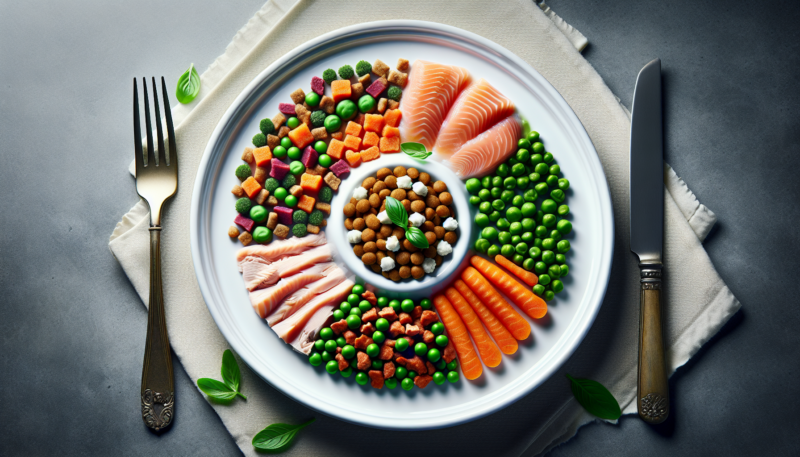Do you ever find yourself wondering what the beloved Persian cats eat to maintain their luxurious coats and playful personalities? Well, look no further! In this article, we will explore the dietary needs of Persian cats and provide you with some helpful tips on how to ensure their nutrition is well-balanced and tailored specifically for their health and well-being. From the best cat food options to essential nutrients, we’ve got you covered! So, let’s dig into the fascinating world of Persian cat nutrition and discover the key to keeping our fluffy friends happy and healthy.

Types of Food for Persian Cats
Dry Cat Food
Dry cat food, also known as kibble, is a popular option for Persian cats. It is convenient, easy to store, and provides essential nutrients for your feline friend. Dry cat food is made by combining various ingredients, such as meat, grains, and vegetables, and then drying it out to create bite-sized kibbles. It is important to choose a high-quality dry cat food that meets the nutritional needs of Persian cats.
Wet Cat Food
Wet cat food is another option to consider when feeding your Persian cat. This type of cat food comes in cans or pouches and contains higher moisture content compared to dry cat food. Wet cat food is often more palatable to cats due to its moist texture and stronger aroma. It can also be beneficial for Persian cats who struggle with hydration, as it provides an additional source of water.
Raw or Homemade Food
Some pet owners prefer to feed their Persian cats a raw or homemade diet. This involves preparing meals using raw meat, bones, organs, and vegetables. While this option allows for more control over the ingredients and can provide a natural and balanced diet, it is crucial to consult with a veterinary nutritionist or veterinarian to ensure that your homemade meals meet the specific needs of your Persian cat.
Feeding Schedule for Persian Cats
Number of Meals per Day
When it comes to the number of meals you should provide for your Persian cat, it is generally recommended to offer two to three meals per day. This feeding schedule helps to regulate their blood sugar levels and prevent overeating or obesity. It is essential to establish a consistent feeding routine and feed your cat at regular times.
Ideal Meal Sizes
Determining the ideal meal size for your Persian cat depends on various factors, including their age, weight, and activity level. It is necessary to follow the feeding guidelines provided by the manufacturer of the cat food you choose. Consider consulting your veterinarian for personalized recommendations based on your cat’s specific needs.
Feeding Guidelines for Different Life Stages
As your Persian cat ages, their nutritional requirements may change. It is crucial to adjust their feeding portions and choose cat food specifically formulated for their life stage. Kittens require more calories and nutrients for growth, while adult and senior cats may have different requirements for maintaining their health and well-being.
Benefits of High-Quality Cat Food
Nutritional Balance
high-quality cat food is formulated to provide a balanced and complete diet for Persian cats. It contains the right proportions of protein, fat, carbohydrates, vitamins, and minerals that are essential for their overall health and vitality. By feeding your Persian cat high-quality cat food, you can ensure that they receive the necessary nutrients to thrive.
Healthy Weight Maintenance
Obesity is a common problem among Persian cats. Feeding them a high-quality cat food can help prevent excessive weight gain and maintain a healthy body weight. Look for cat food labeled as “light” or “weight management” if you have concerns about your Persian cat’s weight.
Improves Digestion
A diet consisting of high-quality cat food can promote better digestion in Persian cats. These cat foods are designed to be easily digestible, reducing the risk of stomach upset, diarrhea, and other gastrointestinal issues. The inclusion of fiber and probiotics in high-quality cat food can also support a healthy digestive system.
Recommended Nutritional Content
Protein
Protein is an essential component of a Persian cat’s diet. It aids in the growth and maintenance of muscles, organs, and tissues. Look for cat food that contains animal-based proteins, such as chicken or fish, as they provide the necessary amino acids that cats need.
Fat
Fat is a valuable source of energy for Persian cats. It also helps with nutrient absorption and provides vital fatty acids for their skin and coat health. Look for cat food that contains healthy fats, such as omega-3 and omega-6 fatty acids, which contribute to a glossy and lustrous coat.
Carbohydrates
While cats are obligate carnivores and do not require carbohydrates in large quantities, a minimal amount of carbohydrates can be included in their diet for energy. It is important to choose high-quality cat foods that contain easily digestible carbohydrates, such as sweet potatoes or brown rice, rather than filler ingredients like corn or wheat.
Vitamins and Minerals
Vitamins and minerals are essential for overall health and proper body function in Persian cats. Look for cat food that includes a blend of vitamins, such as vitamins A, D, E, and B complex, as well as important minerals like calcium, phosphorus, and magnesium.

Avoiding Harmful Foods
Toxic Plants
Certain plants can be toxic to cats, and Persian cats are no exception. It is important to keep potentially toxic plants, such as lilies, azaleas, and daffodils, out of your cat’s reach. Ingesting these plants can cause severe gastrointestinal upset, organ damage, and even be fatal. Be sure to research and identify toxic plants to ensure your Persian cat’s safety.
Common Food Allergens for Cats
Like any other cat breed, Persian cats can develop food allergies or sensitivities. Common food allergens for cats include dairy products, fish, beef, and grains. If you suspect that your Persian cat has a food allergy, consult with your veterinarian to determine the best course of action, such as an elimination diet or allergen testing.
Human Foods to Avoid
While it may be tempting to share your meals with your Persian cat, certain human foods can be harmful to them. Foods like chocolate, onions, garlic, grapes, and alcohol should never be given to Persian cats, as they can cause severe illness or toxicity. Stick to feeding your cat specially formulated cat food and avoid sharing your meals.
Water and Hydration
Importance of Water for Cats
Water is an essential component of a Persian cat’s diet. Cats have a low thirst drive, so it is important to encourage them to drink an adequate amount of water. Water helps maintain proper hydration, supports kidney function, aids digestion, and regulates body temperature. Ensure that your Persian cat has access to fresh and clean water at all times.
Providing Fresh Water at all Times
To encourage your Persian cat to drink water, it is vital to provide fresh and clean water in easily accessible locations throughout your home. Consider using a water fountain designed specifically for cats, as the moving water may attract their attention and encourage them to drink more.
Snacks and Treats
Occasional Treats
Treats can be a fun and rewarding way to bond with your Persian cat. However, it is important to offer treats in moderation to prevent excessive weight gain or nutritional imbalances. Limit the number of treats you give your Persian cat and choose low-calorie options specifically formulated for cats.
Safe and Healthy Snack Options
When selecting snacks for your Persian cat, opt for treats that are made from high-quality ingredients and do not contain any harmful additives or preservatives. Look for treats that are protein-rich, such as freeze-dried chicken or salmon, as these can provide a healthy boost of nutrients.
Feeding Tips for Persian Cats
Slow Feeding Techniques
Persian cats are prone to eating too quickly, which can lead to digestive issues and even choking hazards. To promote slower eating, consider using slow feeders or puzzle feeders. These special bowls or toys are designed to make the cat work for their food, slowing down their eating pace and providing mental stimulation.
Feeding in Elevated Bowls
Due to their unique facial structure, Persian cats may find it more comfortable to eat from elevated bowls. Elevating their food and water bowls can help reduce the strain on their necks and make mealtime more enjoyable.
Using Puzzle Feeders
In addition to slowing down their eating pace, puzzle feeders can also engage your Persian cat’s natural hunting instincts. These interactive toys require the cat to solve puzzles or manipulate objects to access their food. Puzzle feeders provide mental stimulation and physical activity during mealtime.
Special Dietary Requirements for Persian Cats
Hairball Control
Persian cats are known for their luxurious and long coats, which can result in an increased risk of hairballs. To address this issue, consider feeding your Persian cat a hairball control diet. These cat foods contain added natural fibers that help move swallowed hair through the digestive system, reducing the frequency of hairballs.
Urinary Health
Some Persian cats may be prone to urinary tract issues, such as urinary stones or crystals. To support their urinary health, consider choosing cat food that is specifically formulated to maintain a healthy urinary pH and provide essential nutrients that promote urinary tract health.
Sensitive Stomachs
If your Persian cat has a sensitive stomach or experiences digestive issues, it may be necessary to switch to a cat food formulated for sensitive stomachs. These formulas are designed to be gentle on the digestive system and may include ingredients such as easily digestible proteins and limited ingredient lists.
Consulting a Veterinarian
Importance of Veterinary Advice
When it comes to your Persian cat’s diet, it is always recommended to consult with a veterinarian. They can assess your cat’s health, consider any specific dietary requirements or medical conditions, and provide personalized recommendations for their nutritional needs. Your veterinarian is the best source of information and can guide you in making informed decisions regarding your Persian cat’s diet.
Individual Dietary Recommendations
Each Persian cat is unique and may have individual dietary requirements. A veterinarian can provide tailored dietary recommendations based on factors such as their age, weight, activity level, and any existing health conditions. By working closely with your veterinarian, you can ensure that your Persian cat receives the best possible nutrition for their overall health and well-being.
